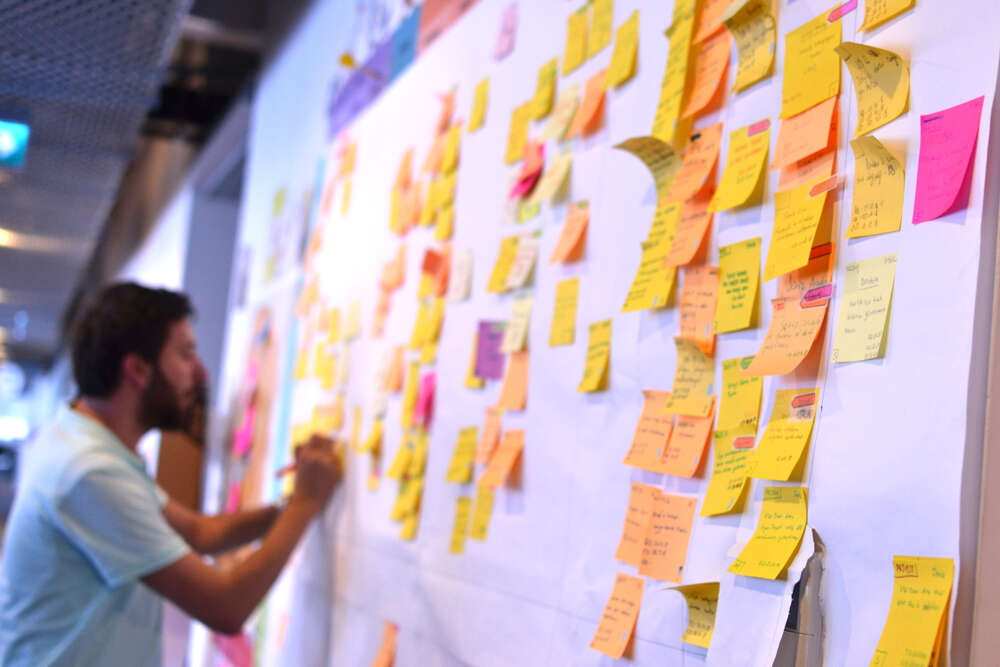
One of the core principles of the Agile methodology is that teams work best when they collaborate face-to-face. That became impossible under lockdown but, in many cases, the shift to online collaboration has improved the Agile process. Not every organisation has been able to adapt but for those that have, the experience could increase the value they derive from Agile working in the long term.

Agile communication during lockdown
Agile teams working remotely is nothing new: many organisations mix on-site and offshore workers in the software development teams. But, in Agile coach and trainer Steve Roy’s experience, communication often suffers in this configuration and the experience is invariably worse for those dialling in.
“You used to have stand-ups in the morning with the team,” says Roy. “The people who were co-located were standing around the board. They would have a Jabra-like speaker, not a very good one, and the offshore people would just be talking into that, and it was very difficult to hear them.”
Roy has an Agile coaching policy: if one person in the team is remote, everyone should work as though they are remote too. But this rarely happened before the pandemic, he says.
Lockdown has removed the barriers between remote and co-located teams by forcing everyone onto the same footing; for example, video calls and online collaboration. For some teams, Roy says, that has improved communication – so much so that he expects some employers to preserve these working practices even as workers return to the office.
“I think that’s quite an interesting challenge for companies coming back into the new normal because you’re not going to go back to that sub-optimal communications structure,” adds Roy. “Even if you are in an office, you’d probably be at your desk with a headset on to talk to people who are either working at home or remote.”
To maintain the quality of this enhanced communication, companies might need to place more screens around the office and continue video meetings. “I can’t really see a situation where [we] go back to black and white, face-to-face situations.”
Agile under lockdown: boosting transparency
Another pillar of Agile that has been disrupted by lockdown is transparency. Kristin Lindmark, CIO at Swedish pensions and investment company SPP, says the methodology allows everyone in her department to see initiatives in the development pipeline that other teams are working on. “When we release new functionality, you can see how fast it gets adapted,” she says.
Before the pandemic, SPP would have up to 150 people gathered in one room to plan the upcoming development work for the next increment. But the company also had experience with Microsoft Teams, and when lockdown came the organisation was able to shift online easily.
“It’s a really powerful way of working with really high engagement,” explains Lindmark. “And the biggest gain is the transparency. We talk about the ‘digital cathedral’ that we are building: everyone should be able to see the whole digital cathedral that you are building, not just a stone that you are carving.”
Everyone should be able to see the whole ‘digital cathedral’ that you are building, not just a stone that you are carving.
Kristin Lindmark, CIO, SPP
The transparency of Agile projects relies in large part on the artefacts of the methodology: in particular, whiteboards and PostIt notes. But digital tools such as Miro, Mural and Google Jamboard allow teams to move their creative processes online, and lockdown has accelerated their adoption. Miro saw a 236% increase in weekly active users in the first few months of the pandemic.
In some ways, these tools are an improvement. “Before, you had limited space on the wall to visualise everything,” says Roy, but online tools “have some advantages like having an infinite whiteboard or a canvas that can be the length of Wembley Stadium”.
The behavioural shift to remote Agile
But while digital tools have improved communication among many Agile teams, they require a behavioural shift, warns Roy. “When people were co-located, it was much easier to ask someone directly because you see them,” he says. “Now you have to make a much more conscious effort to communicate and be open.”
Not all organisations have been able to make this shift, he adds. “I have a coaching friend who was working with a team recently who still emails everyone and they were getting delays in getting answers. Sometimes they would save those same questions for the stand-up the next day.”
He advises caution in recreating the physical workspace online. Some Agile coaches say everyone should have their camera on to replicate face-to-face conversations, but team members may be working in shared accommodation or have another reason to keep their camera off. “If you do that in a training context, you may be inadvertently discriminating against people who are guarded against privacy,” he says.
Organisations that were siloed and hierarchical before lockdown are the ones that are now struggling to adapt, Roy believes. Teams who are organised around delivering value to the customer, and are free to experiment, are the ones who are thriving in lockdown.
“If you were already operating in objectives and key results, and funding teams and products rather than… projects, then you could adapt much easier,” he explains. This is “more or less what Agile is about: the flexibility to adapt and change to [an] uncertain world whilst maximising customer value delivered”.






